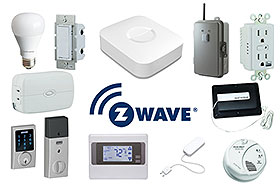

Z-Wave is a wireless protocol that harnesses low-energy radio waves to assist smart devices and appliances to communicate effectively. It consumes very little power and uses frequencies of 908,4 MHz in the USA and 868,42 MHz in Europe. The bandwidth is not anywhere near the band used by Wi-Fi and other protocols and devices (2,4 GHz and 5 GHz), so Z-Wave does not suffer from interference from nearby devices.
As Z-Wave uses little power, devices using this technology do not need frequent battery changes, and sometimes this may only happen once in every ten years. Z-Wave is not designed to carry large amounts of data. It sends data from devices such as motion or thermostat sensors, and thus uses minimal power.
How it works
Z-Wave is a wireless mesh network and can support as many as 232 devices. In typical systems, the practical limit is 40 or 50 devices, after which you start getting congestion. Wireless mesh networks work in reverse: the more devices you add the stronger the mesh, as long as the devices are set up to act as repeaters.
All devices on standard Wi-Fi networks are connected to a router. In mesh networks, the devices on the network link to a central hub, but also mesh to each other. These devices are typically not Wi-Fi enabled, but communication with the hub happens via the Z-Wave protocol.
Mesh networks are comprised of nodes, and smart home devices used in a smart home are referred to as nodes. Messages are sent between nodes, which means the Z-Wave system has extended reach with only very slight, impossible to notice, delays.
In Wi-Fi, data is sent directly from the router to a device, such as a smartphone. In Z-Wave, the mesh network detects data transmitted via the hub to a device, then on to another, and no device is ever out of range. Each Z-Wave device is plugged into an outlet (unless it uses batteries) and acts as a repeater, meaning it broadcasts each message that is sent across the network to each Z-Wave device on the home network.
In the open air, Z-Wave travels up to 100 metres, but practically, the signal does not need to travel such long distances in a home. The signal only moves a short distance from one device to the next, where it bounces or hops off to the next device.
Z-Wave advantages for home automation
Z-Wave has many advantages when it comes to home automation:
• The ability to connect different brands: all Z-Wave devices are compatible. The Z-Wave Alliance has more than 700 members and over 3200 certified products from these different brands.
• Fewer disconnections and less interference: for Z-Wave networks, the more devices the better. Each device improves the network signal, allowing you to create excellent connectivity.
• Secure technology: Z-Wave developers prioritise security, and Z-Wave uses similar encryption methods as those used in online banking, called AES128 encryption. Z-Wave smart home networks have unique IDs assigned to each device on the network, meaning each hub ID is different, and your neighbour cannot take control of your devices.
• Low power consumption as devices using this technology do not transmit large amounts of data.
• Z-Wave allows either local or remote control, meaning you can control your home from anywhere in the world.
• It is easy to install and straightforward. You do not need to hire an electrician to rewire your home.
Signals travel up to 100 metres in open air and 30 metres with obstructions. It is recommended to have a Z-Wave device every 4 hops or roughly every 200 metres.

© Technews Publishing (Pty) Ltd | All Rights Reserved